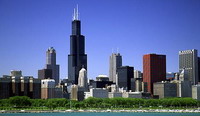Login form
Chicago

Chicago is famous for tall buildings. The world’s first skyscraper was built here in 1885. Today, the city’s skyline includes some of the tallest buildings in the world. The Sears Tower is Chicago’s highest skyscraper. The 110-story building soars 1,450 feet (442 meters) into the air. From its completion in 1974 until 1998, it was the tallest building in the world.
Chicago’s downtown business district is called the Loop. An elevated railway travels in a loop around the area, giving the center of the city its name.
PEOPLE FROM EVERYWHERE
Chicago has about 3 million residents. It is the third largest city in the United States, after New York City and Los Angeles. People from all over the world live in Chicago. The most common languages in the city, after English, are Spanish and Polish.
Chicago’s immigrants have left their mark on the city. Each group settled in its own part of the city, and so today you can find neighborhoods that are Chinese, Indian, Irish, Italian, Lithuanian, Mexican, or Polish, or filled with people of another nationality. Many of these neighborhoods hold on to customs and traditions. In neighborhood restaurants, you can sample some of the favorite foods of Chicago’s many ethnic groups.
African Americans migrated to Chicago in large numbers during World War I (1914-1918). They came from the rural South to work in the city’s factories and mills. Black residents have made Chicago famous for jazz and blues. Today, African Americans make up more than one-third of Chicago’s population.
THE CITY ON THE LAKE
Chicago sits on the western shore of Lake Michigan. The lakefront is very important to the city. In the summer, Chicagoans swim in the lake and sail boats. They go to concerts and summer festivals held along the lake.
Huge, scenic parks line much of the lakefront—Jackson Park, Grant Park, and Lincoln Park. In Jackson Park, you’ll want to visit the Museum of Science and Industry. You can board a German submarine, a legendary train, or a space capsule at the museum. Grant Park has an aquarium, a planetarium, an art museum (the Art Institute), and a natural history museum with fabulous dinosaur skeletons. Lincoln Park Zoo is a great place to see animals up close.
A CENTER FOR INDUSTRY
Chicago got its start in the late 1700s as the dwelling of black trader Jean Baptiste Point du Sable. The settlement grew because of its location. By 1850, Chicago had become a busy Great Lakes port. As railroads and people moved westward in the second half of the 1800s, the city rapidly developed into an important rail hub.
Chicago also grew into a major industrial city. Western miners, farmers, and ranchers shipped their iron ore, wheat, and cattle by train to Chicago. Then, the city’s many steel mills, bakeries, and slaughterhouses produced steel, bread, and beef for shipment to Eastern markets. Today, Chicago is both a major manufacturing center and a major transportation center. For many years, Chicago’s O’Hare Airport was the busiest airport in the world.
THE GREAT FIRE
A huge fire burned a third of Chicago in 1871. It began October 8 when, according to legend, a cow kicked over a lantern in Mrs. O’Leary’s barn. Historians call the disaster the Great Fire. When the flames died out on October 10, the Great Fire had killed 250 people and left 90,000 others homeless.
After the fire, the rebuilding of Chicago provided a great opportunity for architects. They experimented with new building techniques, and the skyscraper was born.
Source: Microsoft ® Encarta

